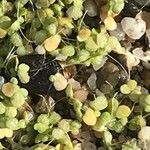Thallus free-floating, surface broadly ovate, yellow-green, asymmetrical, slightly convex, 3–5(–6) mm. long, 2–4(–5) mm. wide, almost hemispherical below and spongy with large inflated hyaline cells and airspaces (even in flat form with large cells evident).. Daughter thalli budding laterally, 2 or 3remaining attached with very short stipes.. Root solitary; sheath unwinged; root-cap 5 mm. long, tip obtuse (rarely acute).. Floral cavity lateral.. Spathe enclosing 2 1-staminate flowers and 1 pistillate.. Fruits narrowly winged above, 1–2-seeded.. Seed ribbed and transversely striate.. Fig. 1/2, p. 3.
Thallus orbicular to obovate, 3–6 mm, nearly symmetrical, solitary or often in groups of 2–4, very often anthocyanic beneath, mottled yellow-green above, or anthocyanic on both sides, ± evidently 3–5-nerved, usually gibbous, the upper surface flat or nearly so and with ± prominent papillae, the lower usually strongly bulged, the tissue with larger and more prominent air-spaces than in no. 3 [Lemna minor L.]; spathe sac-like, open only at the top; fr narrowly winged; seeds (1)2–3(–6), distinctly many-ribbed; 2n=40, 50, 70, 80. Nearly cosmop., but rare and irregular with us.
Perennial herb, hydrophyte. Fronds floating, flattened, ovate, 1-8 x 0.8-6.0 mm, up to 4 mm thick, adaxial surface green, usually red flecked, without distinct papillae, abaxial surface usually red, inflated; largest gas-filled chambers > 0.3 mm in diam. Root usually exceeding 30 mm long; sheath not winged; cap rounded. Inflorescence of 1 female and 2 male flowers enclosed in a membranous sheath. Flowering time Dec.-Feb. Seeds 1-5 per fruit, 0.7-0.9 x 0.4-0.6 mm, with 8-16 longitudinal ribs.
Perennial, aquatic herb. Root sheath not winged, tip mostly rounded (fresh material), often more then 30 mm long. Fronds usually inflated, > 1 mm thick, largest gas-filled chambers more then 0.3 mm in diameter; often with red spots, under surface red. Seeds 1-5 per fruit; with 8-16 longitudinal ribs, whitish; Nov., Dec.
A floating herb. It has thick spongy leaves. They are almost round and 0.8 cm across. There is one small root attached to each leaf. The fronds are bright green on top and grey underneath.
Aquatic herb. Fronds bulbous below, without prominent papules at apex. Wing of fruit 0.1-0.2 mm wide.
Minute, floating aquatic forming large colonies. Leaves spongy. Flowers minute.


